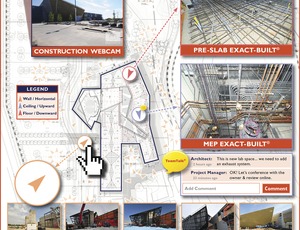

With the proliferation of easy-to-use cameras in smartphones and other electronic devices, contractors can gather an almost unlimited number of project images.
But more is not always better. If a problem arises during construction or after work is complete, how can a contractor be sure it has the right photographs to capture exactly what happened, and why? Photos can be lost or forgotten if not shared immediately or taken too late to be of much use, as is often the case after MEP systems are covered by drywall.
Dave Stadnik recognized this need in 2003, when the Phoenix-based development company he founded began a $25-million commercial construction project.
"There was a lot of paper associated with the project," Stadnik recalls, "but of all the things I paid for, no one had the capacity to show how that money was being spent in a real-time way."
Stadnik heard about MultiVista, a Vancouver, British Columbia-based construction documentation start-up co-founded by former electrician Luis Pascual and materials engineer Graham Twigg. MultiVista offered not only expert digital photography services specifically tailored for construction projects but also technology tools to store and organize the images and to facilitate immediate access across the project team.
"What Luis and Graham offered solved a number of problems with my project and avoided others," Stadnik says. Stadnik was so impressed with MultiVista's potential application to a variety of project types that he joined the company in 2007 as chief operating officer. Headquartered in both Vancouver and Phoenix, MultiVista now operates more than 50 franchises across the U.S., plus locations in Canada and the United Kingdom. All provide a variety of still and video documentation services to owners and contractors, including preconstruction site surveys, interior and exterior progressions and finished surveys of projects ranging from health care and education facilities to stadiums and apartment buildings. Videography and streaming webcam services are also available.
"A contractor may take ... 50 photos over the course of a project, whereas we'll take hundreds, all of which overlap to ensure 100% coverage," explains Ethan Gunnip, operations director for MultiVista's Washington, D.C., office. "The scope and frequency of what we shoot is all dictated by the clients and what they want to see."
Within 48 hours of each shoot, images are linked to a digitized site and floor plans in a cloud-hosted system that Stadnik asserts has "bank-level security." It allows team members to examine photos and collaborate from any location. By clicking on a specific point in the plan, users can see every image for that location during the project, allowing them to monitor progress, verify performance and research quality issues. Photos from other sources can also be uploaded into the system. The cost of MulitVista's core services tends to range from $0.20 to $0.50 per sq ft over the life of the construction phase.
Stadnik says that organization and access differentiate MultiVista from "do-it-yourself" photo documentation. All of MultiVista's high-resolution images are taken systematically from the same pre-identified locations throughout the project by trained photographers, many of whom are former construction trade workers and site supervisors.
"They know what it's like to be on a site and what to look for," Stadnik says. "We train them on our methodology, from shoot patterns to adjusting for various lighting conditions. On site, they capture every wall, every ceiling, every system at exact points in the construction schedule and in close coordination with the other trades." Indeed, Stadnik sees photo-documentation itself as a "trade," providing a clearly organized deliverable—information—that's as critical to a project's success as concrete and piping.
Anthony Bell, Turner Construction Co.'s CMO QA manager for the Transbay Transit Center in San Francisco, agrees with the distinction.
"If you do your own photographs, you need your staff to do it and that takes time," says Bell, whose firm is relying on MultiVista for as-built documentation for the $4.5-billion, 1-million-sq-ft project. "We coordinate with MultiVista, and they go out and take the pictures that are stored along with ours in one place. It's worry free."
Bell recalls a change-order issue in which MultiVista photographs disproved a subcontractor's claim that certain work had been performed. "They're an unbiased source of the documentation, which is a big advantage when there's a dispute," he says.
Samuel Chui, project manager, building design and construction, for the city and county of San Francisco, adds that the power of photo documentation is in the indexing.
"For any construction program, you might have hundreds of photos but with no kind of organization or intent," says Chui, who used MultiVista to document the city's new $243-million Public Safety Campus. "Now, you have an effort to collate and make sense of what's happening on site, especially if you can't be there for the activity."



Post a comment to this article
Report Abusive Comment